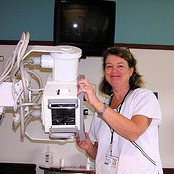Medical technicians work in a variety of fields within the medical profession. Paramedics, lab personnel, veterinary assistants, pharmacy assistants and X-ray techs are all medical technicians. The responsibilities of the med tech depend on the specific career path they have chosen.
Technicians
Radiology and ultrasound technician positions may seem specific, and they are, but medical technicians are not generally restricted to this type of work. CAT (computerized axial tomography) scans and MRIs (magnetic resonance imaging) are other typical areas of interest for the med tech. They have a variety of tasks that may take them to other areas of the hospital or into different fields of study. Again, it just depends on the schooling acquired before and during a med tech's career.
The X-Ray
The use of X-ray techonology is not new to the medical profession. In fact, German scientist Wilhelm Conrad Rontgen discovered it on November 8, 1895. Mr. Rontgen discovered that a cathode-ray tube emitted invisible rays, and that they could penetrate paper and wood. Shooting electromagnetic waves 1,000 times shorter than light waves into the human body, he found that areas of the body could be penetrated more easily than other parts. Since bone and lead are thicker in density than skin, the variance allowed him to make pictures through a series of darker and lighter images. Very shortly after his discovery, doctors in America used it to find broken bones without having to commit the patient to surgery.
The Future
Three companies, all based in the Stockholm region, are working on new X-ray technologies. Scint-X AB is using a scintillator device that allows dentists to be more precise in their diagnoses. RaySearch Laboratories is working on technologies to limit the amount of radiation the patient must endure during treatments. XCounter AB is working on a new 3D technology that uses photon counting principles in their designs. All these companies are looking ahead to ensure more accurate and safer X-ray sampling in cancer treatments, dentistry, mammography, CT and tomosynthesis. This is an old technology, but there are new advances that are reshaping how it works, while limiting the mild dangers associated with it. Photo Source: Flickr [cf]skyword_tracking_tag[/cf]

